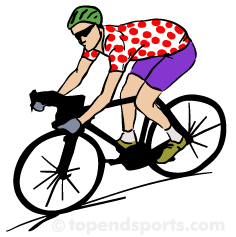In the Tour, a colored jersey is generally associated with each prize, and the current holder of the prize is required to wear the jersey when racing. The rider leading a classification at the end of a stage is required to wear the corresponding jersey during the next stage.
Jerseys are awarded in a ceremony immediately following the stage. Where a single rider leads in the competition for more than one jersey, they wear the most prestigious jersey to which they are entitled, and the second-placed rider in each of the other classifications becomes entitled to wear the corresponding jersey.
Yellow Jersey
The yellow jersey, known in French as the maillot jaune, is worn by the overall time leader, and is the most prized jersey. It is awarded by calculating the total combined race time up to that point for each rider. The yellow jersey was first awarded in 1919 to make the race leader stand out. The color yellow was chosen because the pages of the race sponsor's magazine, L'Auto, were yellow.
 Green Jersey
Green Jersey
The green jersey, known in French as the maillot vert, is awarded to the cyclist with the highest number of sprint points. Points for this jersey are gained by the riders who finish first, second, etc., at the end of each stage. The number of points for each place and the number of riders rewarded varies depending on the type of stage as the flatter stages are more likely to result in a sprint finish. Flat stages give the winner 35 points down to 1 point for the 25th rider; medium mountain stages give the winner 25 points down to 1 point for the 20th rider; high mountain stages give the winner 20 points down to 1 point for the 15th rider. Points are also awarded for individual time trial stages: 15 for the winner down to 1 for the 10th rider. Additional points are available at intermediate sprint contests, usually occurring 2 or 3 times in each stage at pre-determined locations; currently 6, 4 and 2 points are available to the first 3 riders at each sprint.
 Polka Dot Jersey
Polka Dot Jersey
The winner of the King of the Mountain wears a white jersey with red dots (known as the maillot à pois rouges in French), which is commonly referred to as the "polka dot jersey". Although the best climber was first recognized in 1933 as the "King of the Mountain", the distinctive polka dot jersey was not introduced until 1975. The colors were decided by the then sponsor, Poulain Chocolate, to match a popular product. At the top of each climb in the Tour, there are points awarded for the riders who are first over the top. The climbs are divided into categories, from 1 to 4 based on their difficulty with 1 being the most difficult, measured as a function of their steepness and length. A fifth category, called Hors categorie (outside category) is formed by mountains even more difficult than those of the number 1 category. In 2004, the scoring system was changed so that the first rider over a fourth category climb was awarded 3 points while the first to complete a hors category climb would win 20 points. Further points over a fourth category climb are only for the top three places while on a hors category climb the top ten riders are rewarded. Also, beginning in 2004, the points scored on the final climb of the day were doubled if such a climb was at least a second category climb.
 White Jersey
White Jersey
A lesser classification is that for the white jersey (known as the maillot blanc in French), which is like the yellow jersey, but only open for young riders (those who are less than 25 years old on January 1 of the year the Tour is ridden).
Other (non-jersey) Awards
There is a special award for the cyclist that shows the most "fighting spirit" as determined by a group of judges based on points awarded to riders who made particularly attacking moves that day. The rider with most points in total gets a white-on-red (instead of a black-on-white) identification number.
Then there is a team classification which is determined by adding the time of the first three riders from each team after each stage. Historically, the team classification is not associated with a particular jersey design, though starting in 2006, the leading team wears a yellow number attached to their jersey instead of the standard white.
Old Jerseys
There are a few jersey that are no longer awarded. There used to be a red jersey awarded for the standings in non-stage-finish sprints. This jersey and award was abolished in 1989. The red jersey was determined by adding points which were awarded to the first three riders to pass two or three intermediate locations during the stage. These sprints also scored points towards the green jersey and bonus seconds towards the overall classification, as well as cash prizes offered by the residents of the area where the sprint took place. The sprints still remain in the Tour with the bonus seconds, prizes and points towards the green jersey are still awarded
There was also a combination jersey, which had a patchwork design, with areas resembling each individual jersey design. This jersey was presented to the leader of a points system based on standings for the yellow, green, red, and polka-dot jerseys. This was abolished in 1989, the same year the red jersey was abolished.
Other Jerseys
Rainbow Jersey
The current world champion can wear the rainbow jersey when he competes in the Tour de France.
National Jerseys
The current national road race champions can wear their national jerseys in "ordinary stages", while the national time-trial champions are allowed to wear their national jerseys in the time-trial stages only.
Related Pages
- Read how they determine the winners of the Tour
- Tour de France history
- Tour de France home page


 Current Events
Current Events